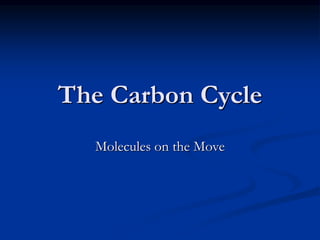
The Carbon Cycle - Power Point.ppt
- 1. The Carbon Cycle Molecules on the Move
- 2. The Carbon Atom All living organisms are based on the carbon atom.
- 3. The Carbon Atom Carbon compounds can be solid, liquid, or gas under conditions commonly found on the earth's surface. Because of this, carbon can help form solid minerals (such as limestone), organisms (such as plants and animals), and can be dissolved in water or carried around the world through the atmosphere as carbon dioxide gas.
- 4. Carbon . . . On the move! Carbon atoms continually move through living organisms, the oceans, the atmosphere, and the crust of the planet.
- 5. The Carbon Cycle This movement is known as the carbon cycle. The paths taken by carbon atoms through this cycle are extremely complex, and may take millions of years to come full circle.
- 7. Consider, for example, the journey of a "typical" carbon atom that existed in the atmosphere as part of a carbon dioxide molecule some 360 million years ago, during the Carboniferous Period. That molecule drifted into the leaf of a large fern growing in the extensive tropical swamp forests of that time.
- 8. Photosynthesis Through photosynthesis, and taking up H2Othe oxygen from the water molecule was released back into the air and the carbon atom was removed from the molecule and used to build a molecule of sugar.
- 9. Carbon . . . Plant Cells The sugar could have been broken down by the plant at a later time to release the energy stored inside, but this particular sugar molecule was transformed instead into a long-lived structural part of one of the plant cells.
- 10. Swamp Soon after, the fern died and the remains sank into the muck at the bottom of the swamp. Over thousands of years, more plants grew in the swamp and their remains also sank into the swamp, forming a layer of dead plant material many metres thick.
- 11. Swamp … to … Rock Gradually, the climate changed, becoming drier and less tropical. Sand, dust, and other materials slowly covered the ancient swamp and sealed the decaying vegetation under an ever-thickening layer of sediment. The sediment hardened, turning to sedimentary rock.
- 12. Coal = Organic Sedimentary Rock The carbon atom stayed trapped in the remains of the long-vanished swamp while the pressure of the layers above slowly turned the material into coals.
- 13. Some 360 million years later, in the 1900s, the coal bed was mined by humans and burned to fuel industrial civilization.
- 14. Release of Energy The process of burning released the energy stored in the carbon compounds in the coal and reunited the carbon atom with oxygen to form again Coal+ O2 → CO2 + H2O
- 15. The Journey Continues The carbon was released to the atmosphere through the smokestack and the journey continues. Many other paths are possible, some taking only hours or days to trace, others, like the one we just learned about, many millions of years
- 16. The Carbon Cycle Carbon may be stored for extended periods (the "sinks") There are various way it is likely to be released to the atmosphere (the "source") There are things that trigger these sources to release carbon (the "release agents") Together they define the carbon cycle.
- 17. “The Sinks” = Where Carbon is Stored Carbon sinks include long-lived trees
- 18. “The Sinks” All living and non- living organisms
- 19. “The Sinks” Limestone (formed from the carbon-containing shells of small sea creatures that settle to the ocean bottoms and build up into thick deposits)
- 20. “The Sinks” Plastic (a modern invention, but very long-lived)
- 21. “The Sinks” And . . . Burial of organic matter (such as those that formed the fossil fuels we use today).
- 22. “The Sources” = How Carbon is Released into the Atmosphere Carbon sources include the burning of fossil fuels and other organic matter
- 23. “The Sources” Weathering of limestone rocks
- 24. “The Sources” The breakdown of substances into simpler molecules is called decomposition. Fungi and bacteria decompose organic matter. Carbon dioxide and water are returned to the environment.
- 25. “The Sources” And . . . The respiration of living organisms. (Cellular Respiration) glucose + O2 → CO2+H2O+ E
- 26. “Releasing Agents” Release agents include volcanic activity, forest fires
- 27. “Releasing Agents” Combustion is the process of burning a substance, such as wood or fossil fuels. Because of combustion, carbon dioxide is released back into the atmosphere.
- 28. “Releasing Agents” And . . . Many human activities.
Editor's Notes
- oxygen and glucose, and produces carbon dioxide, water, and energy. The chemical equation is C6H12O6 + 6O2 → 6CO2 + 6H2O (glucose + oxygen -> carbon dioxide + water